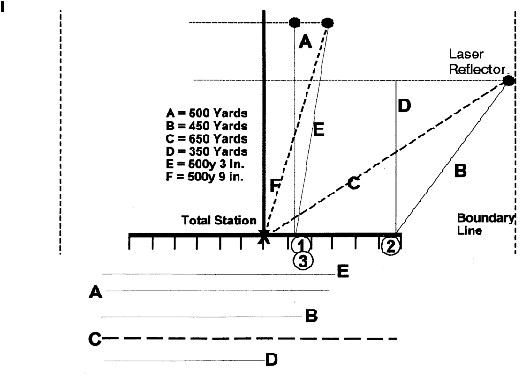Barry Groves tells how Flight distances are measured — the Pursuit of Perfection
You might think that this would be easy — measure from where the arrow is shot
to where it landed. But it is not as simple as that. If that were the only
criterion, archers could shoot from a point in any direction they chose to get
maximum benefit from the wind, for example. This would lead to chaos and, on
most ranges, be extremely dangerous. Boundaries would have to be established to
prevent this. But then archers could try to get as close to a boundary as
possible to get the maximum help from the elements. This could lead to some
difficult 'line calls' as it would be impractical to lay out a physical
boundary.
Throughout history all nations holding Flight Tournaments have measured
distances along a line set from the centre of the shooting line and at right
angles to it ? the World Standard. This way of measuring requires a certain
amount of skill and accuracy on the part of the archer to ensure that his
arrows fall within a reasonable distance of the centre line.
The instrument used for measuring is generally a surveyor's Total Station laser
theodolite in the USA and an optical square in Britain. With the British method
a prism allows the judge to see an arrow to the side of the line. And a plumb
bob dropped to a tape measures the distance. With the theodolite, the actual
distance to the arrow is measured and that is multiplied by the cosine of the
angle from the centre line to determine the distance credited.
It has been suggested that measuring in this way along a centre line does not
reflect the true distance that an arrow has been shot and that, in future, the
measurement should from the point it was shot directly to the arrow. If we
measure the arrow from where it was shot that would indeed be the exact true
distance. However, this would be quite impractical even if there were an £8,000
Leica Total Station Laser theodolite set up at every shooting position.
Here are some examples that I hope will clarify the situation. Please refer to
Figure 1 below:

1. Archer 1 shoots an arrow to A, using his skill and control, keeping his
arrow parallel to the centre line resulting in an exact true distance of 500
yards. Please note that as the Laser is at the centre line, the result is
exactly the same as if measuring from where the arrow was shot.
2. Archer 2 shoots an arrow the distance of B. The exact true distance could
only be determined if the Laser were moved to Archer 2's shooting position, set
up again and measured to the laser reflector from there. This would measure 450
yards. If it were decided that the measurement should be this actual distance,
the laser would have to be moved to every archer's position to measure their
arrow distances — an impossible task.
On the other hand, if Archer 2's shot were measured directly to the arrow from
the centre line C, it would reward the archer's lack of skill (or outright
cheating in taking advantage of the procedure by shooting from a point as far
from the laser position as possible) by adding the distance he was along the
flight line to the length of his shot.
But by measuring Archer 2's shot using the World Standard method of measuring
at a right angle to centre line D, Archer 2 is penalised for his lack of
control of the bow by 100 yards.
3. A final example is where Archer number 1 completes his six arrow end and
then Archer 3 shoots from the same flight line position but shoots slightly
offline to E. Measuring at the World Standard method, these distances would be
tied whereas measuring directly to the arrow from the centre line F directly to
the arrow from the shooting position, Archer 3 would win. The difference in
this example would equate to just a few inches.
The actual distances in real life would not equate to hundreds of yards but
they could still be significant.
All forms of archery have their basis in the traditional uses for bows: either
to hunt for food or for use in war. If an archer in battle were able to target
his arrows on his enemy, while he was still out of range of his enemy's arrows,
he would have an advantage. But there was little point in being able to shoot
further if he couldn't hit what he was aiming for. Thus accuracy at long
distance was also required.
Aside from the skills required in all types of archery, Flight Archers must
cast their arrows in a perfect right angle direction from the shooting line
parallel to the range centre line in order to obtain the maximum distance.
When measuring the World Standard way, provided that there is a minimum 150
metre range width, boundary lines are not required.
Lastly, if a new form of measurement — directly to the arrow ? were to be
adopted, that would invalidate all nations' present Flight Records and those
records recognised as World Records.
I hope that has cleared up the business of measuring distances. It's simple
really: shoot as far as you can and shoot parallel to the centre line.
Last updated 26 November 2002
Related Articles

 HOME
HOME


